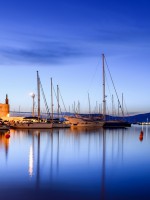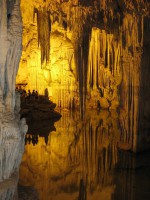Nature

The
Flora and Fauna:
The
Alghero area is covered in the main by Mediterranean maquis, which
– with its mixture of plants – offers up that inimitable
fragrance that every tourist always picks up on as soon as they get
off the plane. Contrary to what you might think, the pine tree is not
native to the island. One of the most well-known Mediterranean scrub
plants is myrtle, which is used by a local company to produce myrtle
liqueur.
The most remarkable creatures in the vicinity include
the colonies of griffon vultures, which can be seen on the coast
between Alghero and Bosa, and around Punta Cristallo, where you can
also see deer, Asinara donkeys and foals in the wild. There are
numerous, brightly coloured species of birds in the skies above this
part of the island, particularly at the Calic basin.
The
Grotte di Nettuno, Sardinia's most famous caves:
The
mouth of the Grotta di Nettuno (Neptune's Cave) is located at sea
level, on the western side of the imposing promontory of Capo
Caccia, which can be reached by sea in one of the boats that leave
from the docks of the old port, or over land, via a long staircase of
656 steps carved out of the rock (the so-called "escala del
cabirol”), which, from a height of 110 metres, descends steeply to
the mouth of the cave, offering panoramic views along the way. The
formation of the cave may date from the early Pleistocene epoch,
around two million years ago.
Near
Neptune's Cave is the Grotta Verde, which can unfortunately no longer
be visited by the public. In this karstic cave, also known as the
“Grotta dell'Altare”, prehistoric graffiti have been found, along
with remains dating from the Neolithic period. The cave, featuring
stalagmites measuring up to 12 metres in height, has over recent
years been subject to works geared towards stabilising it, with a
view to allowing tourists and enthusiasts to visit it once again.
Capo
Caccia-Isola Piana Marine Protected Area:
The
Marine Protected Area is located between Marina di Lioneddu and Capo
Galera. This tract of coast, studded with caves and gorges, is loomed
over by the promontory of Capo Caccia, with cliff faces plunging into
the deep blue sea. The celebrated bay of Porto Conte, which stretches
for a full 6 km, is located here.
The karstic caves with the
evocative names Nettuno, Verde, Palombi, Pizzi and Ricami, constitute
an articulated underground system. Across from the promontory,
formerly a national park, you will find the Piana and Foradada
islands, the latter so-called due to the cave that perforates it. The
bay of Porto Conte includes an expanse of Posidonia
oceanica
(Mediterranean tapeweed), at a depth of between 10 and 35 metres. The
marine environment is in an excellent state of conservation, as
evinced by the presence of colonies of red coral at a depth of
between 40 and 50 metres – hence the name "Riviera del
Corallo" or Coral Riviera. At the same depth are populations of
violescent sea-whip and sponges of the Axinella genus. The Marine
Protected Area, established in late 2002, extends across a surface
area of 2,631 hectares and is managed by Alghero City Council.
(link sito amp)
Coral
Corallium
rubrum
(red coral), which grows abundantly along the coast of Alghero, has
been used to make necklaces since ancient times. Coral fishing was
traditionally carried out by experts who would dive down more than
100 metres. Today, fishing for coral is prohibited.
The branches
are selected on the basis of their colour and thickness, and it is
the thickness that makes the piece suitable for working. Colour and
compactness are other important elements.
The craftspeople of
Alghero are experts at carving coral into exceptional pieces of
jewellery.









